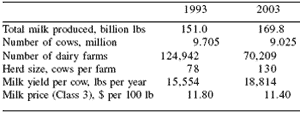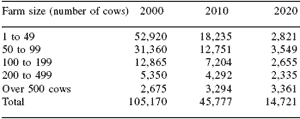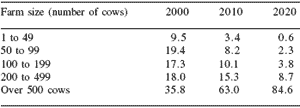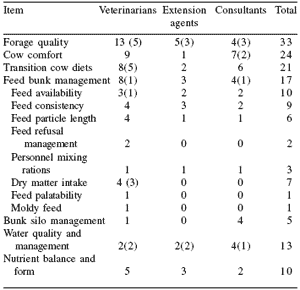Meeting the educational needs of dairy clientele in 2020
LOOKING BACK: CHANGES IN THE PAST 10 YEARS
The largest shift in US dairy production patterns has been where milk is being produced in the country. The western area in 1993 produced 35% of all US milk and had 31% of the dairy cows. In 2002, the West accounted for 41% of US dairy cows and produced 45% of all milk, growing in average herd size from 190 cows to 412 cows per herd. Table 1 summarizes changes over the last 10 years (1993 to 2003). Summary points are listed below.
• Total milk yield increased on average 1.2% annually. The trend toward more milk may shift, depending on the aging US population, new dairy products (e.g. a ‘new’ pizza), health concerns, advertising and marketing of dairy products, and export opportunities.
• Total cow numbers declined less than 1% annually. This trend may slow depending on trends in consumption (demand for dairy products).
• Milk yield per cow increased on average 2.1% annually, a figure which includes the impact of BST (commercial use began in 1994). Opportunities remain, as the average milk yield is 18,814 lbs while many herds average over 25,000 lbs and individual cows can exceed 40,000 lbs of milk. Larger herd sizes are associated with increased milk yield per cow.
• The number of dairy herds has dropped by 44%. This trend will continue as herd sizes increase to meet the demand for milk by consumers. The shift to larger herd size will reduce the number of dairy farm managers while increasing demands for unique services (feeding, reproduction, health, and financial consultants).
• Average herd size doubled in the last 10 years. This trend will depend on the management style of the farm manager or family.
• Milk prices remain constant, leading to tighter profits margins and increased emphasis on efficiency.
Table 1. US dairy statistics, 1993 and 2003.
Halladay, 2004
THE DAIRY INDUSTRY IN 2020
Milk production will increase while cow numbers decline and dairy farm numbers will drop. Larger herd sizes (250 to 3000 cows per unit with multiples of these base numbers) will continue. Dairy farms will produce 1.2 to 1.5 million lbs of milk per full time employee equivalent. Milk processing companies may target semi-load(s) of milk from the farm (600 milking cows per load). Table 2 summarizes projected numbers of dairy farms in the United States, assuming that milk consumption of dairy products remains constant (LaDue et al., 2004).
Table 2. Projected number of dairy farms in the US.
LaDue et al., 2004
Large herds (over 500 cows) increased cow numbers by 4% over the last year. The majority of milk will be produced on farms milking over 500 cows.
Distribution of cows within herds will be a key factor that could impact sustainability of the operation and the need for various types of educational alternatives. Table 3 lists the distribution of milk production by herd size. Factors that could alter trends are outlined below.
• Economic risk favors larger herd sizes by $0.50 per 100 lbs (cwt) of milk produced. Smaller herds will need to offset this advantage to remain competitive.
• Health and disease risk increase with herd size as more people and higher cattle concentration occur.
• Environmental risk will be a concern as current concentrated animal feed operations (CAFO) regulations apply only to large farms. In the future, all farms may be required to meet these regulations. Smaller herds with fewer cows over which to spread this investment will be forced to make economic decisions. Environmental Quality Incentive Program (EQIP) can provide up to $450,000 per farm depending on future funding commitments by the government.
• Marketing risk could be a factor if milk processors provide incentives for larger milk volumes picked up at the farm. The swine industry has future contracting and shackle space guarantees to ensure timely marketing. Will smaller dairy farms have a market?
Table 3. Percentage of milk production by herd size in the US.
LaDue et al., 2004
Dairy managers as education clients In the education process to date, the primary focus has been the dairy farm manager. Dairy farm systems can be divided into different management groups requiring alternative methods for education delivery.
FAMILY DAIRY SYSTEMS
Traditional ‘family’ dairy systems will continue to be a primary management group. This group will have the following characteristics that will dictate educational approaches.
• The labor source will include the owner, daughter(s) and son(s) in-law, herdsperson and/ or part-time youth.
• The size of the operation will depend on the number of family members employed with a target of 50 to 70 cows per full time employee equivalent.
• Milk production per cow will be high (25% above the national average).
• Sales of surplus dairy cattle can be a source of income. Registered dairy cattle breeders may remain in this category.
Educational programs that could appeal to this group include traditional approaches such as mass media, educational meetings, tours, and targeted topics (accelerated calf growth, lameness, milk components, and crossbreeding).
LOW INPUT DAIRY SYSTEMS
Low input dairy systems are popular in regions that have land suited to grazing and a traditional dairy history. These dairy farms have been referenced as ‘sustainable farms’ with the following characteristics.
• Family members are the only source of labor.
• Herd size will remain stable over time dictated by labor and land resources.
• Milk yield may be below the national average (90%).
• The ‘New Zealand system’ dairies are included in this group (pasture systems, larger number of cows (100 to 150 lactating cows per full time equivalent), and large parlors to reduce milking time to less than 2 hrs per milking).
• Investment per cow is minimized with little equipment owned, custom planting of crops and harvesting of forages, and/or off-farm purchase of feeds.
• Off-farm employment may be needed for supplemental income and insurance benefits.
The educational needs of this group will be specific for individual dairy managers and will apply to their particular situation. Tours, success stories in mass media, and production tips will be useful educational approaches. These individuals will need educational efforts to be close to their farms, as travel time or employment will be limiting factors. Weekend programs may be needed.
INTENSIVE DAIRY FARMS
Intensive dairy farms reflect larger dairy units (listed in Tables 2 and 3). These farms will increase in number as competition and milk processors favor these systems. The following characteristics can apply to this dairy model.
• Herd size will vary from 250 to 3000 cows with multiples of each size per farm (for example a herd of 12,000 cows may consist of units with 3000 cows for optimal management by one management team).
• Milk yield will be high as the latest technology and health programs will enhance performance and quality.
• Labor will be provided by outside resources, necessitating labor management skills and strategies for dealing with language limitations.
• Economics will be the driving factor as decisions are based on return on investment (not convenience or drudgery).
• The ability to assemble semi-loads of milk will allow market alternatives and premiums.
• Profit margins for suppliers will be tight as volume discounts may be expected by these dairy managers.
This group will require unique educational opportunities that may be targeted specifically for their farm(s), for example heat detection systems, feed delivery, or benchmarks to monitor economic success. The educational program may be delivered at the farm level allowing employees or managers to balance time availability with specific farm learning needs. Attending traditional educational programs is not popular; while networking with similar operations is perceived as more useful (invitational meetings, one-on-one sessions with specialists, and companysponsored activities).
Agri-business as client
A second group of clients for educational programs are agri-business ‘educators’ as they serve dairy managers. ‘Training the trainer’ multiplies educator impact, resulting in more effective changes on farms, and a greater ability to deliver the recommendation (for example by including the educational concept in the feed delivered to the farm). Three groups are outlined below.
VETERINARIANS
Veterinarians are ‘the’ on-farm experts (defined by the dairy manager) that understand herd dynamics and health changes. If the veterinarian supports a feeding or management change, it will happen on her or his client farms. The veterinarian can be an effective method to indirectly reach dairy managers. If one Midwest dairy veterinarian is ‘sold’ on a concept (for example drenching cows), she or he can implement this program on 30 to 60 dairy farms.
Training for veterinarians can include AABP (American Association of Bovine Practitioners)national meetings and programs, state veterinary meetings, and local programs. Some states require continuing education (CE) credits be earned by veterinarians (another reason why veterinarians are potential clients).
REGIONAL FEED SUPPLIERS
Regional feed suppliers can react quicker than national feed suppliers. These suppliers are aware of local needs, are seen as part of the community (anti- Walmart image), and maintain ties to the community. These organizations may not have large research and marketing departments, and need to develop ways of staying current and updated.
CONSULTANTS
Consultants will play a more important role as increased herd sizes creates the demand for more specific information and guidelines. Many of these individuals will have advanced degrees (beyond the bachelor degree) and understand the science behind research studies. These individuals or groups will need to maintain cutting edge knowledge of their specialties through non-traditional approaches. Unique educational programs specific for this group (such as one-on-one discussions) may be popular.
The Illinois distance learning approach Illinois Extension continues to change educational programs as their clientele base changes. With slightly over 1200 dairy farms (ranging from 27 to 2700 cows per herd), Illinois Extension delivers research results and recommendations via ten area Illinois Dairy Day programs, an annual dairy research summary, dairy records program using PC DART, and regional meetings arranged through the Four State Dairy Team (WI, MN, IA, and IL). Mass media plays a major role delivering information through Hoard’s Dairyman, Dairy Today, Hoard’s West, Dairy Herd Management, Midwest Dairy Business, AgriView, AgriNews and other media outlets. Participating in national and international programs expands the reach and focus of Illinois dairy extension programs. All information is available on the internet at http:// www.traill.uiuc.edu/dairynet/.
Another opportunity occurred in 1998 when the University of Illinois offered instructional grants through a new program initiative called U of I On- Line. Administrators felt the future for education was on-line, reaching students across the state and around the world. Because dairy feeding classes had been taught across Illinois as traditional classes in the 1990s (classroom style with face-to-face lectures), a competitive grant was obtained ($122,200). The Illinois Dairy Certificate program was the only successful grant in the College of Agriculture and is outlined below.
• Five on-line classes were developed - Principles of Dairy Science (AnSci 200) - Advanced Dairy Management (AnSci 300) - Advanced Dairy Nutrition (AnSci 373) - Advanced Dairy Reproductive Physiology (AnSci 374) - Milk Secretion and Mastitis and Quality (AnSci 375)
• An on-line laboratory section is available to apply principles in the five classes including breed identification, CMT milk test, hand calculated and computerized ration formulation, feed identification, heifer growth, milk progesterone testing for pregnancy, and record analysis.
• When the student completes the five classes and lab section, they receive a Dairy Certificate from the University of Illinois (certified by the Graduate College at the University of Illinois).
This is not a masters’ degree, but indicates successful completion of the course material and exams.
Individuals not interested in the Dairy Certificate Program can enroll in specific classes as needed or desired. The enrollment costs vary from $400 to $500 depending on whether the student is enrolled for credit (undergraduate or graduate) or audit (visitor) status and hours of credit. Each class has the following characteristics.
• Classes are conducted for 10 to 11 consecutive weeks.
• Each class has a CD that has all lectures recorded, edited, and ready to review when the student has time to listen during the week.
• Each week’s assignment consists of 4 to 8 modules with 15 minute listening time (single topic lecture) including 15 to 20 slide sets that can be printed to take notes and list questions while listening.
• Once a week, instructor(s) will hold a formal class for 1 hr on the internet. Students can listen to the discussions, type in questions, and review homework. All 1 hr programs are recorded and archived for students that cannot attend or need to review.
• For students enrolled for academic credit, homework is assigned each week (requires 15 to 30 minutes to complete depending on the student’s background) and is sent electronically to the instructor for grading. A take-home final exam completes class assignments. Discussion questions and research paper reviews can be used by instructors to enhance the learning experience.
The CD can also be purchased as a reference tool to learn or use. The Advanced Dairy Feeding class (AnSci 373) has trained approximately 350 students using the internet class while over 1200 CDs have been sold ($45 for US students; $60 for foreign students). The CD can be purchased at http:// www.fass.org/UofI/.
Evaluation of the distance learning approach has been favorable to excellent (Hutjens and Baltz, 2000). The availability of dairy education on an ‘as needed’ basis, the flexibility of CD modules, ability to interact with instructors without being on campus, use of expertise from several different areas and universities, and CD teaching applications have been listed as advantages of the Illinois system.
Agri-business has also partnered with the Illinois CD/Internet distant learning approach through support of program development, distribution of the CDs to their key customers and participation in continuing education programs for specific disciplines.
Future nutritional challenges
As Holstein herds achieve higher milk yields, nutrition needs increase to meet milk and reproduction requirements. The University of Illinois Extension conducted a national survey using the Monsanto Dairy Advisers and Technical Support Specialists. Each person was asked to rank in order five factors that they see limiting cows from reaching high yield milk. Thirty-one individuals responded including 17 veterinarians, six extension educators, and eight consultants. Table 4 summarizes their ranking and emphasis of the five factors.
Table 4. Survey results from the 31 specialists divided by groups and ranking.
The number in parentheses indicates the number of individuals that listed this factor as the number one ranked factor limiting cows for increased milk production. Each factor was ranked by awarding one point for the area or factor and an additional one point if it was the respondent’s first-ranked factor.
Forage quality was number one in the group. Bunk management would have been first if all sub-factors (listed under bunk management in Table 4) were included as one factor. Respondents were specific about numerous feed bunk-related factors. It is also interesting to note the differences in the importance and variation of responses by job classification and on-farm responsibilities.
In summary
After reviewing changes in the US dairy industry, clientele needs, and reduced extension commitments, the author’s biases on futuristic dairy educational programs are outlined below.
• The need of for research-based information will be remain important in 2020.
• Dairy managers will want more specific and targeted educational information that meets needs for their farms and employees.
One-on-one training and education will be in greater demand (extension administration will not encourage this method of education delivery).
• Regional feed companies will be a factor if they can develop a local identity and meet local needs.
• The internet and distance learning approaches will continue to be a way to reach dairy clientele with information.
• Land grant universities will reduce faculty time for traditional extension programs, require cost recovery, and will emphasize the need for educational grants.
• The dairy industry (producers and agri-business) will need to come forward and support extension efforts (financially and vocally) or lose these educational efforts.
• Extension educators need to provide futuristic information (food safety, environment quality, consumer concerns, and systems approach) along with traditional information (feeding, mastitis, culling, and other management topics) in a format the clientele need and support.
References
Author: MICHAEL F. HUTJENSHalladay, D. 2004. Ten years later, how much has changed? Hoard’s West 6:1:W2.
Hutjens, M.F. and J.H. Baltz. 2000. Keeping extension programs current in order to meet the needs of a dynamic dairy industry. J. Dairy Sci. 83:1412.
LaDue, E., B. Gloy and C. Cuykendall. 2004. Which farms will produce the nation’s milk in 2020? Hoard’s Dairyman 49:2:49.
Department of Animal Sciences, University of Illinois, Urbana, Illinois, USA









